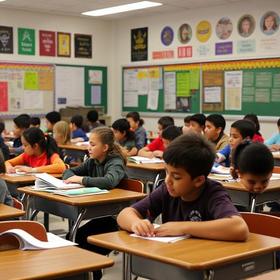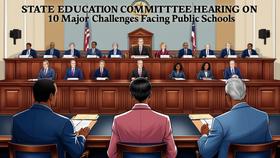Michigan Youth Challenge Academy serves 113 students in grades 9-12.
The student-teacher ratio of 16:1 is lower than the Michigan state level of 17:1.
Minority enrollment is 38% of the student body (majority Black), which is higher than the Michigan state average of 37% (majority Black).
Quick Facts (2025-26)
- School Type: Alternative school
- Grades: 9-12
- Enrollment: 113 students
- Student-Teacher Ratio: 16:1
- Minority Enrollment: 38%
- Graduation Rate: ≥95% (Top 10% in MI)
- Source: National Center for Education Statistics (NCES), MI Dept. of Education
Top Rankings
Michigan Youth Challenge Academy ranks among the top 20% of public schools in Michigan for:
Category
Attribute
Graduation Rate
Community Size
School Overview
Michigan Youth Challenge Academy's student population of 113 students has declined by 8% over five school years.
The teacher population of 7 teachers has grown by 16% over five school years.
School Type
Grades Offered
Grades 9-12
(Supplemental Virtual)
(Supplemental Virtual)
Total Students
113 students
Gender %
Total Classroom Teachers
7 teachers
Year Founded
1999
School Mascot
Eagles
School Rankings
The diversity score of Michigan Youth Challenge Academy is 0.57, which is more than the diversity score at state average of 0.56. The school's diversity has stayed relatively flat over five school years.
Student-Teacher Ratio
16:1
17:1
American Indian
n/a
1%
Asian
n/a
4%
Hispanic
11%
9%
Black
19%
18%
White
62%
63%
Hawaiian
n/a
n/a
Two or more races
8%
5%
All Ethnic Groups
Graduation Rate
≥95%
81%
Participates in the National School Lunch Program (NSLP)
Yes
Eligible for Free Lunch
61%
50%
Eligible for Reduced Lunch
2%
4%
School Statewide Testing
School District Name
Source: National Center for Education Statistics (NCES), MI Dept. of Education
School Notes
- School Mascot: Eagles
Profile last updated: 02/09/2025
Frequently Asked Questions
What is the graduation rate of Michigan Youth Challenge Academy?
The graduation rate of Michigan Youth Challenge Academy is 95%, which is higher than the Michigan state average of 81%.
How many students attend Michigan Youth Challenge Academy?
113 students attend Michigan Youth Challenge Academy.
What is the racial composition of the student body?
62% of Michigan Youth Challenge Academy students are White, 19% of students are Black, 11% of students are Hispanic, and 8% of students are Two or more races.
What is the student-teacher ratio of Michigan Youth Challenge Academy?
Michigan Youth Challenge Academy has a student ration of 16:1, which is lower than the Michigan state average of 17:1.
What grades does Michigan Youth Challenge Academy offer ?
Michigan Youth Challenge Academy offers enrollment in grades 9-12 (Supplemental Virtual).
What school district is Michigan Youth Challenge Academy part of?
Michigan Youth Challenge Academy is part of Marshall Public Schools.
School Reviews
5 10/10/2025
hi ive been to Hoosier youth challenge acadamy would i be able to join this school because i want to get into the military.
5 10/10/2025
Best time of my life, making friends and memories and lots of skills unlocked.
5 10/10/2025
This program is Michigan's best kept secret. Outstanding academic program for at risk youth, this program gave my son a second chance at a future. Public school ruled him out as a child with no promise he now has a 4.0 GPA. This school has an Outstanding staff of dedicated teachers and cadre who care.
Review Michigan Youth Challenge Academy. Reviews should be a few sentences in length. Please include any comments on:
- Quality of academic programs, teachers, and facilities
- Availability of music, art, sports and other extracurricular activities
Recent Articles

How Public Schools Support Students on Free / Reduced-Lunch Programs
Explore how U.S. public schools support students eligible for free or reduced-price lunch through nutrition, academic, and wraparound services in 2025.

Hidden Costs of Public Schools: Fees, Supplies & Extras
Explore the hidden costs in public schools—fees, supplies, extracurriculars—and how parents can plan for them in 2025.

Public School Funding 2025: What Families Should Know
Essential insights on public school funding in 2025—how it works, what’s changing, and what families should know to stay ahead.









